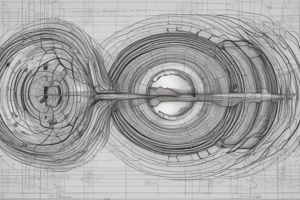Podcast
Questions and Answers
What is the purpose of disabling multifocal technology?
What is the purpose of disabling multifocal technology?
- To reduce line density
- To potentially increase frame rate (correct)
- To increase the number of pulses per line
- To improve image accuracy
What determines the line density in ultrasound imaging?
What determines the line density in ultrasound imaging?
- The frame rate of the system
- The number of pulses per line
- The number of scan lines per unit area (correct)
- The bit depth of the image memory
What is the advantage of high line density in ultrasound imaging?
What is the advantage of high line density in ultrasound imaging?
- Reduced bit depth
- Improved image accuracy and detail (correct)
- Reduced frame rate
- Improved temporal resolution
What is contrast resolution dependent on in ultrasound imaging?
What is contrast resolution dependent on in ultrasound imaging?
What is the effect of increasing the number of bits per pixel in ultrasound imaging?
What is the effect of increasing the number of bits per pixel in ultrasound imaging?
What is the PRF formula related to in ultrasound imaging?
What is the PRF formula related to in ultrasound imaging?
What is the orientation of lateral resolution in ultrasound?
What is the orientation of lateral resolution in ultrasound?
What determines axial resolution in ultrasound?
What determines axial resolution in ultrasound?
What is the mnemonic for Lateral, Axial, Transverse, and Angular?
What is the mnemonic for Lateral, Axial, Transverse, and Angular?
What is elevational resolution also known as?
What is elevational resolution also known as?
What affects elevational resolution in ultrasound?
What affects elevational resolution in ultrasound?
What is the consequence of inadequate elevational resolution?
What is the consequence of inadequate elevational resolution?
What dimension does elevational resolution describe in ultrasound imaging?
What dimension does elevational resolution describe in ultrasound imaging?
Axial resolution varies with what?
Axial resolution varies with what?
What type of artifact can result from poor elevational resolution?
What type of artifact can result from poor elevational resolution?
What is the primary factor that affects temporal resolution in ultrasound systems?
What is the primary factor that affects temporal resolution in ultrasound systems?
What is the unit of measurement for temporal resolution?
What is the unit of measurement for temporal resolution?
What is the result of decreasing imaging depth in ultrasound?
What is the result of decreasing imaging depth in ultrasound?
What is the consequence of reducing line density in ultrasound?
What is the consequence of reducing line density in ultrasound?
Why is temporal resolution crucial in echocardiography?
Why is temporal resolution crucial in echocardiography?
What is the term for the erroneous representation of anechoic structures, such as cysts, appearing filled?
What is the term for the erroneous representation of anechoic structures, such as cysts, appearing filled?
Which factor directly affects the temporal resolution in an ultrasound system?
Which factor directly affects the temporal resolution in an ultrasound system?
What is the unit of measurement for temporal resolution in ultrasound systems?
What is the unit of measurement for temporal resolution in ultrasound systems?
What is the effect of decreasing the imaging depth in ultrasound?
What is the effect of decreasing the imaging depth in ultrasound?
What is the consequence of reducing the line density in ultrasound imaging?
What is the consequence of reducing the line density in ultrasound imaging?
Why is temporal resolution crucial in echocardiography?
Why is temporal resolution crucial in echocardiography?
What determines lateral resolution in ultrasound imaging?
What determines lateral resolution in ultrasound imaging?
What is the effect of using a shorter pulse with high frequency in ultrasound imaging?
What is the effect of using a shorter pulse with high frequency in ultrasound imaging?
What is the consequence of inadequate elevational resolution in ultrasound imaging?
What is the consequence of inadequate elevational resolution in ultrasound imaging?
What is the third dimension of detail resolution in ultrasound imaging?
What is the third dimension of detail resolution in ultrasound imaging?
What affects the elevational resolution in ultrasound imaging?
What affects the elevational resolution in ultrasound imaging?
What is the dimension described by elevational resolution in ultrasound imaging?
What is the dimension described by elevational resolution in ultrasound imaging?
What is the relationship between axial resolution and depth in ultrasound imaging?
What is the relationship between axial resolution and depth in ultrasound imaging?
What is the effect of increasing line density in ultrasound imaging?
What is the effect of increasing line density in ultrasound imaging?
What is the purpose of the formula Frame Rate X Line Density= PRF?
What is the purpose of the formula Frame Rate X Line Density= PRF?
How does the bit depth of an image affect contrast resolution?
How does the bit depth of an image affect contrast resolution?
What is the consequence of closely packed lines in ultrasound imaging?
What is the consequence of closely packed lines in ultrasound imaging?
What property of tissues is contrast resolution dependent on?
What property of tissues is contrast resolution dependent on?
What is the relationship between frame rate and line density in ultrasound imaging?
What is the relationship between frame rate and line density in ultrasound imaging?
Flashcards are hidden until you start studying
Study Notes
Ultrasound Resolution
- Axial resolution: front to back, parallel to beam, determined by pulse length
- Lateral resolution: side by side, perpendicular to beam, determined by beam width
- Mnemonic for axial and lateral resolution: LARD (Linear, Axial, Range, Depth) and LATA (Lateral, Azimuthal, Transverse, Angular)
Elevational Resolution (Slice Thickness)
- Describes the width of the imaging plane, perpendicular to the image plane
- Influenced by the height of the transducer's element
- Inadequate elevational resolution can lead to partial-volume artifacts
Temporal Resolution
- Refers to the capacity of an ultrasound system to depict motion and changes in anatomy over time
- Directly affected by the frame rate, which is the frequency at which consecutive images are captured and displayed
- Measured in Hertz (Hz), representing the number of frames captured per second
- Factors affecting frame rate: speed of sound, imaging depth
- Strategies to improve frame rate:
- Narrow the imaging sector
- Decrease imaging depth
- Reduce line density
- Disable multifocal technology
Line Density in Ultrasound Imaging
- Refers to the number of scan lines per unit area in an ultrasound image
- Achieved with closely packed lines, improving image accuracy and detail (spatial resolution)
- Higher line density can reduce temporal resolution
Contrast Resolution
- Refers to the ultrasound system's capacity to differentiate between tissues with varying echogenic properties
- Dependent on the bit depth - the number of bits per pixel stored in the image memory
- Increasing the number of bits per pixel allows for more shades of gray, enhancing contrast resolution
Ultrasound Resolution
- Axial resolution: front to back, parallel to beam, determined by pulse length
- Lateral resolution: side by side, perpendicular to beam, determined by beam width
- Mnemonic for axial and lateral resolution: LARD (Linear, Axial, Range, Depth) and LATA (Lateral, Azimuthal, Transverse, Angular)
Elevational Resolution (Slice Thickness)
- Describes the width of the imaging plane, perpendicular to the image plane
- Influenced by the height of the transducer's element
- Inadequate elevational resolution can lead to partial-volume artifacts
Temporal Resolution
- Refers to the capacity of an ultrasound system to depict motion and changes in anatomy over time
- Directly affected by the frame rate, which is the frequency at which consecutive images are captured and displayed
- Measured in Hertz (Hz), representing the number of frames captured per second
- Factors affecting frame rate: speed of sound, imaging depth
- Strategies to improve frame rate:
- Narrow the imaging sector
- Decrease imaging depth
- Reduce line density
- Disable multifocal technology
Line Density in Ultrasound Imaging
- Refers to the number of scan lines per unit area in an ultrasound image
- Achieved with closely packed lines, improving image accuracy and detail (spatial resolution)
- Higher line density can reduce temporal resolution
Contrast Resolution
- Refers to the ultrasound system's capacity to differentiate between tissues with varying echogenic properties
- Dependent on the bit depth - the number of bits per pixel stored in the image memory
- Increasing the number of bits per pixel allows for more shades of gray, enhancing contrast resolution
Studying That Suits You
Use AI to generate personalized quizzes and flashcards to suit your learning preferences.




